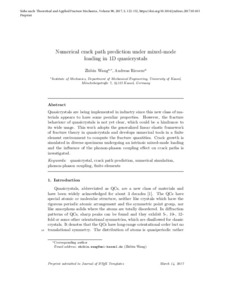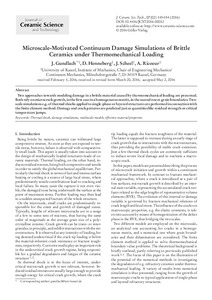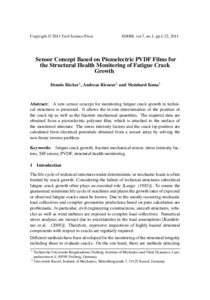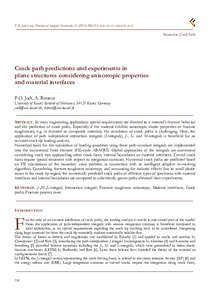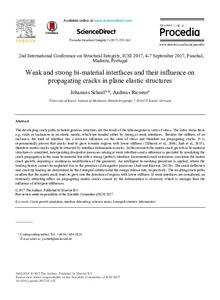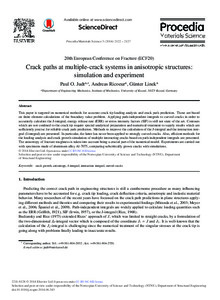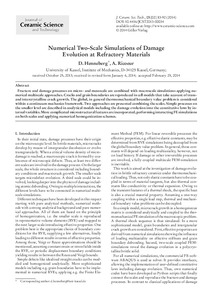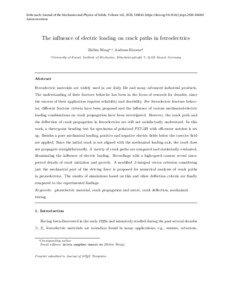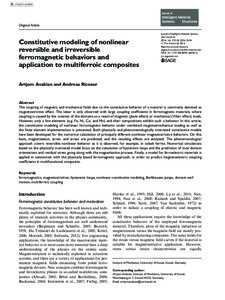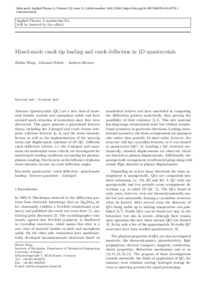Suche
Anzeige der Dokumente 1-10 von 13
Preprint

 Numerical crack path prediction under mixed-mode loading in 1D quasicrystals
Numerical crack path prediction under mixed-mode loading in 1D quasicrystals
(2017-03)
Quasicrystals are being implemented in industry since this new class of materials appears to have some peculiar properties. However, the fracture behavior of quasicrystals is not yet clear, which could be a hindrance to its wide usage. This work adopts the generalized linear elastic framework of fracture theory in quasicrystals and develops numerical tools in a finite element environment to compute the fracture quantities. Crack growth is simulated in diverse specimens undergoing an intrinsic mixed-mode loading and ...
Aufsatz

 Microscale-Motivated Continuum Damage Simulations of Brittle Ceramics under Thermomechanical Loading
Microscale-Motivated Continuum Damage Simulations of Brittle Ceramics under Thermomechanical Loading
(2016-05-02)
Two approaches towards modeling damage in a brittle material caused by thermomechanical loading are presented.
Bothrelyonmicrocrack growth, in the first case in ahomogeneousmatrix, in the second one at grain boundaries.Two-scale simulations e.g. of thermal shocks applied to single-phase or layered structures are performed in connection with the finite element method. Damage and crack patterns are predicted just as quantities like residual strength or critical temperature jumps.
Aufsatz

 Sensor Concept Based on Piezoelectric PVDF Films for the Structural Health Monitoring of Fatigue Crack Growth
Sensor Concept Based on Piezoelectric PVDF Films for the Structural Health Monitoring of Fatigue Crack Growth
(2011)
A new sensor concept for monitoring fatigue crack growth in technical structures is presented. It allows the in-situ determination of the position of the crack tip as well as the fracture mechanical quantities. The required data are obtained from a piezoelectric polymer film, which is attached to the surface of the monitored structure. The stress intensity factors and the crack tip position are calculated from electrical potentials obtained from a sensor array by solving the non-linear inverse problem.
Aufsatz

 Crack path predictions and experiments in plane structures considering anisotropic properties and material interfaces
Crack path predictions and experiments in plane structures considering anisotropic properties and material interfaces
(2015-09-28)
In many engineering applications special requirements are directed to a material's fracture behavior and the prediction of crack paths. Especially if the material exhibits anisotropic elastic properties or fracture toughnesses, e.g. in textured or composite materials, the simulation of crack paths is challenging. Here, the
application of path independent interaction integrals (I-integrals), J-, L- and M-integrals is beneficial for an accurate crack tip loading analysis.
Numerical tools for the calculation of loading ...
Aufsatz

 Weak and strong bi-material interfaces and their influence on propagating cracks in plane elastic structures
Weak and strong bi-material interfaces and their influence on propagating cracks in plane elastic structures
(2017-09-06)
The developing crack paths in heterogeneous structures are the result of the inhomogeneous state of stress. The latter stems from e.g. voids or inclusions in an elastic matrix, which are bonded either by strong or weak interfaces. Besides the stiffness of an inclusion, the kind of interface has a decisive influence on the state of stress and therefore on propagating cracks. It is experimentally proven that cracks tend to grow towards regions with lower stiffness (Tilbrook et al., 2006; Judt et al., 2015), therefore ...
Aufsatz

 Crack Paths at Multiple-crack Systems in Anisotropic Simulation and Experiment
Crack Paths at Multiple-crack Systems in Anisotropic Simulation and Experiment
(2014-06-27)
This paper is targeted on numerical methods for accurate crack tip loading analysis and crack path prediction. Those are based on finite element calculations of the boundary value problem. Applying path-independent integrals to curved cracks in order to accurately calculate the J-integral, energy release rate (ERR) or stress intensity factors (SIF) is still not state of the art. Contours which are not confined to the crack tip require special analytical preparation and numerical treatment to supply results which are ...
Aufsatz

 Numerical Two-Scale Simulations of Damage Evolution at Refractory Materials
Numerical Two-Scale Simulations of Damage Evolution at Refractory Materials
(2014-02-25)
Fracture and damage processes on micro- and mesoscale are combined with macroscale simulations applying numerical multiscale approaches. Cracks and grain boundaries are reproduced in cell models that take account of transand intercrystalline crack growth. The global, in general thermomechanical boundary value problem is considered within a continuum mechanics framework. Two approaches are presented combining the scales. Simple processes on the smaller level are described in analytical models including the damage ...
Aufsatz

 The influence of electric loading on crack paths in ferroelectrics
The influence of electric loading on crack paths in ferroelectrics
(2020-05-30)
Ferroelectric materials are widely used in our daily life and many advanced industrial products. The understanding of their fracture behavior has been in the focus of research for decades, since the success of their application requires reliability and durability. For ferroelectric fracture behavior, different fracture criteria have been proposed and the influence of various mechanical-electric loading combinations on crack propagation have been investigated. However, the crack path and the deflection of crack ...
Aufsatz
 Constitutive modeling of nonlinear reversible and irreversible ferromagnetic behaviors and application to multiferroic composites
Constitutive modeling of nonlinear reversible and irreversible ferromagnetic behaviors and application to multiferroic composites
(2016-03-10)
The coupling of magnetic and mechanical fields due to the constitutive behavior of a material is commonly denoted as magnetostrictive effect. The latter is only observed with large coupling coefficients in ferromagnetic materials, where coupling is caused by the rotation of the domains as a result of magnetic (Joule effect) or mechanical (Villari effect) loads.
However, only a few elements (e.g. Fe, Ni, Co, and Mn) and their compositions exhibit such a behavior. In this article, the constitutive modeling of nonlinear ...
Aufsatz
 Mixed-mode crack tip loading and crack deflection in 1D quasicrystals
Mixed-mode crack tip loading and crack deflection in 1D quasicrystals
(2016)
Quasicrystals (QC) are a new class of materials besides crystals and amorphous solids and have aroused much attention of researchers since they were discovered. This paper presents a generalized fracture theory including the J-integral and crack closure integrals, relations between J1, J2 and the stress intensity factors as well as the implementation of the near-tip stress and displacement solutions of 1D QC. Different crack deflection criteria, i.e. the J-integral and maximum circumferential stress criteria, are ...

